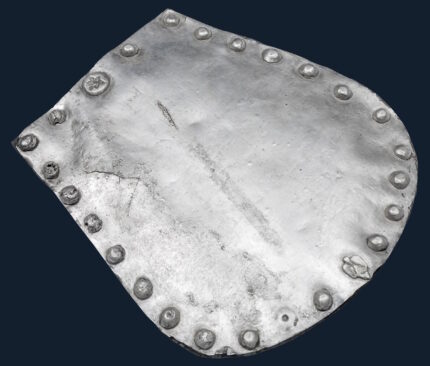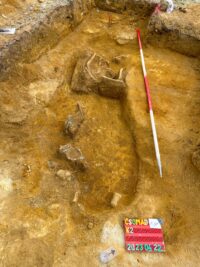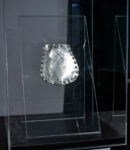 A cavalry burial containing a rare silver sabretache plate was unearthed in an excavation near the village of Csomád, outside Budapest, Hungary, this July. The artifact consists of a silver exterior plate riveted to an interior bronze plate, and dates to the 10th century Hungarian conquest of the Carpathian Basin.
A cavalry burial containing a rare silver sabretache plate was unearthed in an excavation near the village of Csomád, outside Budapest, Hungary, this July. The artifact consists of a silver exterior plate riveted to an interior bronze plate, and dates to the 10th century Hungarian conquest of the Carpathian Basin.
During this period in Hungary, a hierarchical clan-based system determined what men of rank could wear to signify their position. Soldiers wore ornamented weapons, weapon belts and tools that telegraphed their military ranks, positions and affiliations. The sabretache was a leather pouch that contained the essential tools to make fire: flint, tinder and a carbon steel fire striker. They were worn on the right side of their sword belts and were ornamented with bronze, silver or gold plates, depending on the bearer’s rank and proximity to the prince. Fewer than 30 sabretache plates are known in Hungarian museums.
 The find site was first located by a volunteer with the local community archaeology program. Because it was actively under cultivation and subject to occasional metal mining, its archaeological remains were under constant threat. Volunteers and professionals teamed up to excavate it with all due speed.
The find site was first located by a volunteer with the local community archaeology program. Because it was actively under cultivation and subject to occasional metal mining, its archaeological remains were under constant threat. Volunteers and professionals teamed up to excavate it with all due speed.
The team unearthed the grave of a man who died in the mid-10th century. He was a warrior, buried with a horse of which partial remains survive and archery equipment. The grave had been damaged by agricultural works, but the remains were still in unusually good condition. Not only was the metal plate intact, but remnants of the leather strap were as well.
 Many other objects were recovered from the grave. They were removed en bloc with their surrounding soil so they could be excavated and conserved in a restoration laboratory. The plate has already been conserved and is now on display at the Ferenczy Museum Center in Szentendre, joining every other known sabretache plate discovered in Hungary in an unprecedented dedicated exhibition.
Many other objects were recovered from the grave. They were removed en bloc with their surrounding soil so they could be excavated and conserved in a restoration laboratory. The plate has already been conserved and is now on display at the Ferenczy Museum Center in Szentendre, joining every other known sabretache plate discovered in Hungary in an unprecedented dedicated exhibition.
Friends,
Perhaps the historic term for this pouch should be “tarsoly”, which according to Wikipedia were carried by Magyar warriors in the 10th century. “Sabretasche”, derived from the German “Säbeltasche”, and is more identified with 18th century hussars.
Yours Aye,
Mungo Napier, Laird of Mallard Lodge (SCA)
Yes, but tarsoly is virtually the same thing. The only difference is that later on it grew in size, was adopted by various cavalry armies (especially hussars), and was used more or less as a useful “carry-all” bag.
As far as medieval cavalry is concerned, I am unsure if already the I*anian cataphracts (from κατάφρακτος, “completely enclosed”), or clibanarii, had similar bags. In Central Europe, however, the Hungarian threat led to the erection of fortified castles and a newly framed society.
Accordig to Widukind of Corvey’s ‘Res gestae Saxonicae’, a 10th century chronicle, Henry the Fowler built an extensive system of fortifications and mobile heavy cavalry to neutralize the Magyar threat. Among the agrarian soldiers, he chose every 9th (“primum quidem ex agrariis militibus nonum”) to live in a castle.
Jurisdiction, markets and convents should be held in those special places (“Concilia et omnes conventus atque convivia in urbibus celebrari”). The previous system of armoured horsemanship was reorganized. However, the Roman emperor Valerian had been captured by Pe*sian cataphracts, already in the 3rd century.
BTW, the Vettersfelde Treasure suggests “Scythian influences” in Central Europe, and near Castra Regina (Regensburg, Bavaria) somebody raided Roman ‘villae rusticae’, scalped the inhabitants and threw their severed heads down the well, a process –with horses involved– already described by Herodotus.